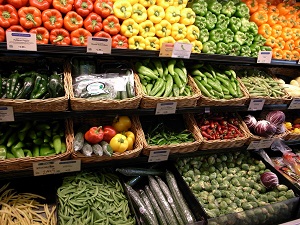
Healthy Food is Good for You and Your Wallet
Savvy consumers can not only save money while food shopping but they can eat healthier at the same time. Yes, it’s possible to both slim your waistline while fattening your wallet!
Follow these simple tips and you come out ahead at the bank and healthy in the body:
-
Plan Ahead and Eat Ahead – don’t let impulse buying at the grocery store derail your budget or impulse eating — a.k.a, having brunch at Costco — derail your diet. Have a menu plan, create an inventory of what you have on hand, gather your coupons (both print and digital and eat something before you hit the aisles.
As far as coupons go, keep in mind that many store brands provide excellent quality and represent a better value than the national brands even when you have a coupon.
-
Healthier food choices can actually save you money. Yeah, I know, I’ve seen the prices for fresh produce but consider this, when you eat well studies show that you actually eat less. The heavily processed foods that we too often consume are loaded with both empty calories and the type of ingredients that encourage us to eat more.
By eating healthier we’re also saving on our health related expenses by maintaining a healthy weight and keeping our cholesterol and other food related conditions at bay.
One measure when making health conscious choices is to use nutrient rather than calorie content to guide us.
-
Know what’s in season and buy accordingly. Buy fresh, buy local and shop the farmer’s markets. Their a fun way to get good food while getting fresh air and exercise to boot.
-
Packing a lunch will unpack the pounds. You’ll save money and time by spending 15 minutes making your lunch in the morning instead of 45 minutes standing in line at the food court for fast food chock full of stuff you don’t need to be chock full of…
-
Think outside the box, or can or freezer when making food choices. Use the best form of food for the circumstances. Consider whether frozen, canned or dried food is as good a substitute as the fresh ingredients called for in a recipe. Each has their advantage. Dried fruit can be a great substitute for fresh and frozen foods allow you to use only what you need and keep the rest frozen for future meals.
-
Meet your protein needs without meat. Meat is great. I love meat but wow can it suck the green out of a wallet! Consider protein substitutes such as eggs, legumes, tofu, eggs and other protein rich foods rather than those expensive cuts of meat. You can save a bundle on poultry by learning how to butcher the whole bird than buying the pre-skinned, deboned chickens at the grocers. Consider making bulk meat purchases and portioning them into freezer bags for consumption over time.
-
Be a Zero sum food consumer. In other words, don’t add to the 30 million tons of food we Americans waste each year. When you meal plan be sure and plan for how you’ll use your leftovers as well. Last nights mashed potatoes can make yummy potato cakes for tomorrow’s breakfast.
-
Get Growing. That’s right, plant a garden. Whether you have a plot of land or a few containers there’s nothing like slicing your own fresh picked tomatoes for your dinner salad or blending up your just harvested basil for a super fresh pesto! If you have enough space and enough ambition you can also learn how to freeze and can to enjoy the bounty of your backyard – or back porch, all year long.
Good spending habits and good eating habits go hand-in-hand with these simple tips. Good luck and good eating!
Photo: License![]() Some rights reserved by Masahiro Ihara
Some rights reserved by Masahiro Ihara


